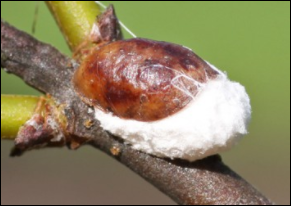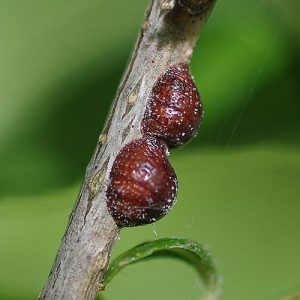Cottony maple scale is an annoying pest. The crawlers feed on the sap of their host trees and deprive them of nutrition. They also excrete high volume of liquid waste that harbors molds and gives a sooty appearance to the trees and the area underneath. This pest can weaken trees, which may lead to infections, diseases, branch dieback, and discoloration of leaves. Death of infested tree is rarely reported and therefore, you don’t need to adopt an aggressive cottony maple scale control  and management strategy.
and management strategy.
If you have noticed cottony, popcorn like egg masses on branches and twigs of your maple or deciduous trees, here are some cottony maple scale control methods to take.
Cottony Maple Scale Control and Management
Assess the Level of Infestation – Is It Light or Severe?
If scale numbers are low (say 4-5 egg masses per branch), you don’t need to do anything. Mature and healthy trees are capable of tolerating cottony maple scale infestation for 2-3 years consecutively. The natural predators of this pest will help them recover from the infestation within a few years.
Use Biological Control or Natural Predators
Many parasites and predators feed on the eggs and crawlers of cottony maple scale. Introducing them to your garden or landscape is probably the safest cottony maple scale control and management method to look into. The major predators include ladybird beetles, some wasps, and fly parasites. The beetles enter the ovisacs to dine on the eggs of the cottony maple scale. If the eggs are already hatched, they will settle on the nymphs and will lay their eggs in them. The larvae of the beetles will then devour the scale crawlers from inside out. This biological process is time-consuming, yet it is very effective in controlling and even eliminating maple scale infestations.
Nurture and Care For Your Trees
Stressed out or weakened trees are more susceptible to cottony maple scale infestation. Poor fertilization, poor watering, and poorly aerated soil are some more factors that can promote maple scale growth. Severe infestation may lead to branch diebacks, infection, and even death of trees. Improving the health of trees can help them deal with the infestation. Follow a recommended fertility program and watering regime. Aerate the soil regularly and avoid over-fertilization. If possible, grow chives, marigolds, cosmos, feverfew, sea lavender, mustard, and calendula in your landscape. These plants are known for attracting ladybird beetles.
Use Chemicals (Only When Necessary)
Chemical cottony maple scale control and management is not required unless the infestation is heavy and the honeydew dripping is intolerable. Most insecticidal sprays and dormant oils are

mature female with her egg/ovisac of waxy fibers
harmful to natural predators of maple scale. Further, they are not safe for Japanese maples and may harm other maple varieties as well. Before you use them, read the product label thoroughly.
- Killing the overwintering females can help control their population significantly. The best way to do this is to spray them with dormant horticultural oil. You can buy the oil from your nearby gardening store. Spray the trees in early spring before the new growth is seen. The oil will suffocate the over-wintering females and will kill them.
- Spraying the trees just after the eggs have hatched is also very effective in controlling scale population. You will have to spray them twice, first time in mid-July and again in August. Double spraying ensures complete protection. You can use horticultural soaps or oil for spraying. Mix them with water in appropriate proportion (as mentioned on the product label) and spray them thoroughly on the entire tree, especially on the underside of the leaves where the crawlers have attached themselves. Horticultural sprays do not leave any residue and therefore, you will have to repeat the application after 10-15 days. These sprays, however, are not safe for some species of maple and may harm the natural predators of this pest.
- If the infestation is severe, you may opt for pesticide application. Several pesticides are registered for maple scale control. You can buy them from your nearby gardening store. They must be sprayed thoroughly on the upper and underside of the leaves so that the leaves get wet. Usually, two applications are required for effective control.
While pesticide and horticultural sprays are effective, the timing and coverage can make a lot of difference to the results you achieve. If the infestation is severe, you must not try handling the situation on your own. Instead, contact your nearby pest control company to find out the best solution.

No Comments